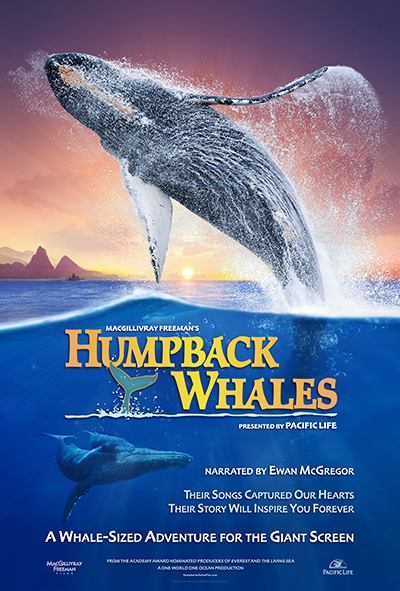There’s no bigger or better way to make an impact than through a presentation in full giant-screen 70 mm IMAX 3D.
 So the message about the beauty and importance of protecting humpback whales is delivered in the most inspiring and action-motivating way in the latest documentary production by MacGillivray Films, “Humpback Whales,” presented (subsidized) by Pacific Life
So the message about the beauty and importance of protecting humpback whales is delivered in the most inspiring and action-motivating way in the latest documentary production by MacGillivray Films, “Humpback Whales,” presented (subsidized) by Pacific Life , the latter the 149-year-old life insurance company with the familiar logo of a humpback whale in a majestic back-arched breech.
, the latter the 149-year-old life insurance company with the familiar logo of a humpback whale in a majestic back-arched breech.
As with all 38 MacGillivray Films (“Everest,” “The Living Sea,” “Grand Canyon Adventure”), the 40-minute “Humpback Whales,” which opens in selected museum/destination theaters this Friday, Feb. 13 (California Science Center July 3), is filled with staggering shots of these massive creatures from close-up underwater to just above the water line to high above from helicopters.
Director Greg MacGillivray said at a media screening Saturday, Feb. 7, that most of the filming on the $8 million production was done in the unusually calm and glassy waters off Lanai, Hawai’i and around the South Pacific islands that make up the Kingdom of Tongva, where whaling, once a way of life, is now outlawed but swimming with whales is still allowed.
<Story/review continues below the following 1:45 video of comments by Greg MacGillivray and trailer for the movie…>
Although MacGillivray told 3DHollywood.net/HollywoodInHiDef.com that he was intentionally more restrained with this film in terms of not creating many sequences where something protrudes from the screen out to the audience, the 3D is no less dramatically apparent, particularly in sequences such as the enormously fascinating “bubble netting” feeding process. He also uses the soundtrack to great effect with the seat/bone-rattling bass sounds of the whale songs/calls only about half of what it felt like when he experienced it firsthand from about 200 yards away.
The strategic integration of the popular American Authors song “Best Day of My Life” is also effective.
Actor Ewan McGregor, who was also at the screening Saturday with young children, narrates the story that follows portions of migration of whales and illuminates how little is known about how and where whales mate, as well as how social they can be, even with humans as they circle one of the small boats of the production crew.
The message here is that while the population of humpback whales has returned to nearly half of what it once was since whaling was been banned in most countries beginning in the 1970s, there is still much work to be done to discourage whaling in countries such as Japan, Norway, and Iceland, and there are still too many incidents of whales getting fatally entangled in human ocean litter and getting rammed and killed by ships. The filmmakers and Pacific Life recommend visiting OneWorldOneOceanFoundation.org to learn how you can help.
— By Scott Hettrick
